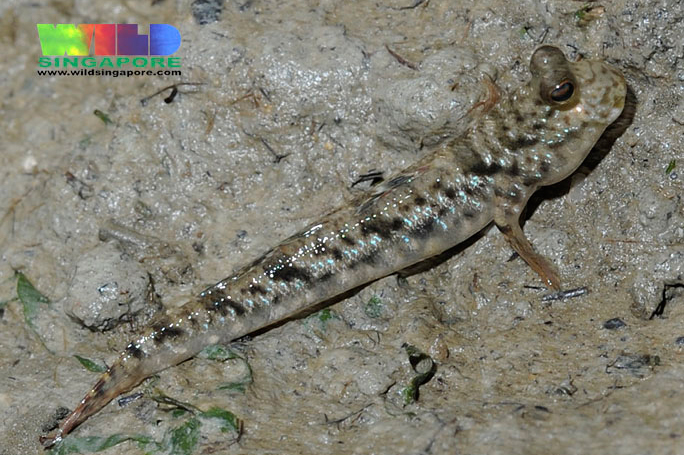Dusky-gilled Mudskipper, Periophthalmus variabilis Eggert 1935
Other Names: Dusky Gilled Mudskipper

A Dusky-gilled Mudskipper, Periophthalmus variabilis, at Kampong Pasir Ris, northeast Singapore, August 2009. Source: Ria Tan / http://www.wildsingapore.com/ via Flickr. License: CC By Attribution-NonCommercial-NoDerivatives
Summary:
A brown mudskipper becoming whitish below with dark brown blotches and iridescent blue speckles on the head and body, 5-8 irregular diagonal brown saddles along the back, and dark gill membranes.
The first dorsal fin has a broad dark submarginal stripe (often darker anteriorly), and reddish-orange rounded to elliptical spots. The second dorsal fin has a yellow-orange margin, a black submarginal stripe, and rounded red-orange spots on the membrane between the rays. The outer part of the caudal fin is orange with a series of brownish speckles. The outer part of the pectoral fins are orange to reddish, the anal fin is whitish to yellowish, and the pelvic fins are whitish to dusky.
Video of Dusky-gilled Mudskippers in Malaysia, September 2009.
The first dorsal fin has a broad dark submarginal stripe (often darker anteriorly), and reddish-orange rounded to elliptical spots. The second dorsal fin has a yellow-orange margin, a black submarginal stripe, and rounded red-orange spots on the membrane between the rays. The outer part of the caudal fin is orange with a series of brownish speckles. The outer part of the pectoral fins are orange to reddish, the anal fin is whitish to yellowish, and the pelvic fins are whitish to dusky.
Video of Dusky-gilled Mudskippers in Malaysia, September 2009.
Cite this page as:
Bray, D.J. 2018, Periophthalmus variabilis in Fishes of Australia, accessed 18 Apr 2024, https://fishesofaustralia.net.au/Home/species/5424
Dusky-gilled Mudskipper, Periophthalmus variabilis Eggert 1935
More Info
|
Photo Rights |
Dusky Gilled Mudskippers (P. variabilis), Malaysia. 20160922 |
|
Features |
Dorsal fin VIII-XI + 12-13; Anal fin 11-13; Longitudinal scale count 48-60; Predorsal scales 17-22; Anal-fin base 18.3-21.1% SL; pelvic fins with prominent frenum and inner rays united by a basal membrane for less than half their length; First dorsal-fin spine moderately elongated in larger specimens. Branchiostegal membrane pigmented. |
|
Colour |
First dorsal fin with a dark inframarginal stripe (often darker anteriorly), and reddish-orange rounded to elliptical spots. Second dorsal fin with a yellow-orange margin, a black inframarginal stripe, and round red-orange spots on the membrane between the rays. |
|
Biology |
Dusky-gilled mudskippers construct burrows amongst mangrove roots. |
|
Species Citation |
Periophthalmus variabilis Eggert 1935, Zoologische Jahrbücher, Abteilung für Systematik, Geographie und Biologie der Tiere (Jena) 67: 64, Pl. 3 (fig. 13), Fig. 5. Type locality: Hutan Payau, Tritih, Cilacap, cantral Java, Indonesia. |
|
Author |
Bray, D.J. 2018 |
Dusky-gilled Mudskipper, Periophthalmus variabilis Eggert 1935
References
Eggert, B. 1935. Beitrag zur Systematik, Biologie und geographischen Verbreitung der Periophthalminae. Ergebnisse einer durch die Notgemeinschaft der Deutschen Wissenschaft ermöglichten Reise nach Niederländisch-Indien ...der Deutschen Wissenschaft 1929--1930. Zoologische Jahrbücher, Abteilung für Systematik, Geographie und Biologie der Tiere (Jena) 67: 29-116, Pls. 1-9.
Jaafar, Z. & Larson, H.K. 2008. A new species of mudskipper, Periophthalmus takita (Teleostei: Gobiidae: Oxydercinae), from Australia, with a key to the genus. Zoological Science 25: 946-952.
Jaafar, Z., Perrig, M. & Chou, L.M. 2009. Periophthalmus variabilis (Teleostei: Gobiidae: Oxudercinae), a valid species of mudskipper, and a re-diagnosis of Periophthalmus novemradiatus. Zoological Science 26: 309–314.
Konstantinidis, P., Jaafar, Z., Warth, P., Stoll, M. & Hossfeld, U. 2016. Rediscovery of oxudercine type specimens (Teleostei: Gobiidae) assumed destroyed during World War II. Ichthyological Research: 1-8. https://doi.org/10.1007/s10228-016-0532-9 Abstract
Murdy, E.O. 1989. A taxonomic revision and cladistic analysis of the oxudercine gobies (Gobiidae: Oxudercinae). Records of the Australian Museum Supplement 11: 1–93 (as a synonym of Periophthalmus novemradiatus)
Polgar, G. & Crosa, G. 2009.Multivariate characterization of the habitats of seven species of Malayan mudskippers (Gobiidae: Oxudercinae). Marine Biology 156(7): 1475-1486. DOI: 10.1007/s00227-009-1187-0 Abstract
Takita T., Agusnimar & Ahyudin B. A. 1999. Distribution and habitat requirements of oxudercine gobies (Gobiidae: Oxudercinae) along the Straits of Malacca. Ichthyological Research 46 (2): 131–138.





